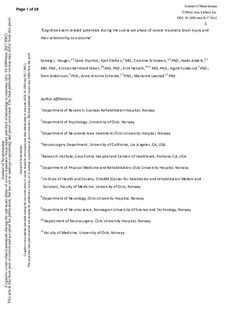Cognitive event-related potentials during the sub-acute phase of severe traumatic brain injury and their relationship to outcome
Hauger, Solveig Lægreid; Olafsen, Kjell; Schnakers, Caroline; Andelic, Nada; Nilsen, Kristian Bernhard; Helseth, Eirik; Funderud, Ingrid; Andersson, Stein; Schanke, Anne-Kristine; Løvstad, Marianne
Journal article, Peer reviewed
Accepted version
Permanent lenke
http://hdl.handle.net/11250/2498782Utgivelsesdato
2017Metadata
Vis full innførselSamlinger
Sammendrag
Predicting outcome in the early phase after severe traumatic brain injury (sTBI) is a major clinical challenge, particularly identifying patients with potential for good cognitive outcome.The current single-center prospective study aimed to explore presence and normalization of electroencephalography (EEG)-based event-related potentials (ERPs) in the early phase followings TBI, and their relationship to functional and cognitive outcome 6 months post-injury. Fourteen adult patients (eight males) with sTBI were recruited from the neurointensive care unit (mean age = 38.2 years [standard deviation (SD) = 14.7]; mean lowest Glasgow Coma Scale (GCS) score within first 24 h = 5.4, SD = 1.87). EEG recordings were conducted biweekly at three time-points applying an ERP paradigm encompassing a passive condition involving hearing their own name randomly interspersed between an unfamiliar name (UN), and an active condition with instruction to count their own name. Functional and cognitive outcome 6 months post-injury was measured with Glasgow Outcome Scale-Extended (GOSE) and neuropsychological tests of attention and memory. Ten patients demonstrated a significantly enhanced cognitive P3 in the active counting task compared with passive listening across recordings, and six presented with normalization of P3 in the counting task. Moreover, P3 amplitude to the counting task at the third time-point was positively correlated with both functional outcome (GOSE) and cognition (verbal learning, attentional set-shifting, and switching) 6 months post-injury. ERP can index cognitive capacities in the early phase following sTBI, and the cognitive P3 component in an active design is associated with functional and cognitive outcome, demonstrating that the cognitive P3 may yield valuable information of residual cognition and provide supplementary prognostic information.
